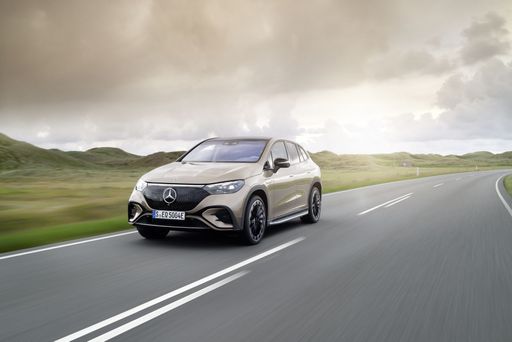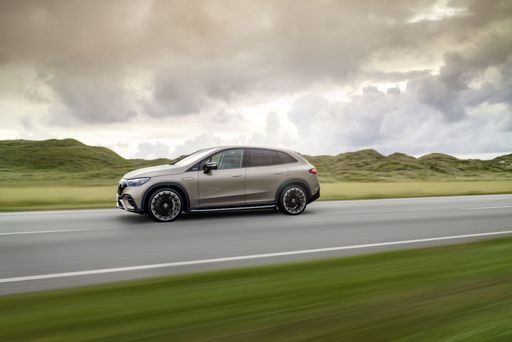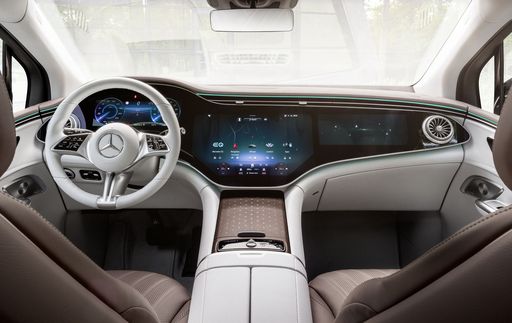Mercedes EQE SUV vs Renault Trafic Bus – Differences & prices compared
Compare performance, boot space, consumption and price in one view.
Find out now: which car is the better choice for you – Mercedes EQE SUV or Renault Trafic Bus?
The Mercedes EQE SUV (SUV) comes with a Electric engine and Automatic transmission. In comparison, the Renault Trafic Bus (Bus) features a Diesel engine with Manuel transmission.
When it comes to boot capacity, the Mercedes EQE SUV offers 520 L, while the Renault Trafic Bus provides – depending on how much space you need. If you’re looking for more power, decide whether the 625 HP of the Mercedes EQE SUV or the 150 HP of the Renault Trafic Bus suits your needs better.
In terms of consumption, the values are 18.30 kWh per 100 km for the Mercedes EQE SUV, and 6.80 L for the Renault Trafic Bus.
Price-wise, the Mercedes EQE SUV starts at 71600 £, while the Renault Trafic Bus is available from 38200 £. Compare all the details and find out which model fits your lifestyle best!
Mercedes EQE SUV
The Mercedes-Benz EQE SUV represents a fusion of advanced electric mobility and luxurious design, offering a refined driving experience that aligns with the brand's renowned legacy. Inside, the cabin is adorned with high-quality materials and state-of-the-art technology, providing both comfort and functionality for modern drivers. Its dynamic exterior is crafted to enhance aerodynamics while maintaining a distinctive and elegant presence on the road.
details @ group-media.mercedes-benz.com
@ group-media.mercedes-benz.com
 @ group-media.mercedes-benz.com
@ group-media.mercedes-benz.com
 @ group-media.mercedes-benz.com
@ group-media.mercedes-benz.com
 @ group-media.mercedes-benz.com
@ group-media.mercedes-benz.com
Renault Trafic Bus
The Renault Trafic Bus is a versatile and spacious option for those needing to transport multiple passengers comfortably. With its modern design and practical features, it is well-suited for both business and leisure purposes. Its efficient engine and smooth handling make it a reliable choice for long journeys.
details

|
|
|
|
|
Costs and Consumption |
|
|---|---|
|
Price
71600 - 125100 £
|
Price
38200 - 51100 £
|
|
Consumption L/100km
-
|
Consumption L/100km
6.8 - 7.2 L
|
|
Consumption kWh/100km
18.3 - 23.1 kWh
|
Consumption kWh/100km
-
|
|
Electric Range
453 - 611 km
|
Electric Range
-
|
|
Battery Capacity
90.5 - 96 kWh
|
Battery Capacity
-
|
|
co2
0 g/km
|
co2
179 - 188 g/km
|
|
Fuel tank capacity
-
|
Fuel tank capacity
80 L
|
Dimensions and Body |
|
|---|---|
|
Body Type
SUV
|
Body Type
Bus
|
|
Seats
5
|
Seats
8 - 9
|
|
Doors
4
|
Doors
4
|
|
Curb weight
2440 - 2615 kg
|
Curb weight
2031 - 2321 kg
|
|
Trunk capacity
520 L
|
Trunk capacity
-
|
|
Length
4863 - 4879 mm
|
Length
5080 - 5480 mm
|
|
Width
1940 mm
|
Width
1956 mm
|
|
Height
1672 - 1685 mm
|
Height
1973 - 1974 mm
|
|
Payload
505 - 580 kg
|
Payload
749 - 982 kg
|
Engine and Performance |
|
|---|---|
|
Engine Type
Electric
|
Engine Type
Diesel
|
|
Transmission
Automatic
|
Transmission
Manuel
|
|
Transmission Detail
-
|
Transmission Detail
Manual Gearbox
|
|
Drive Type
All-Wheel Drive, Rear-Wheel Drive
|
Drive Type
Front-Wheel Drive
|
|
Power HP
265 - 625 HP
|
Power HP
110 - 150 HP
|
|
Acceleration 0-100km/h
3.7 - 7.1 s
|
Acceleration 0-100km/h
13.6 - 16.5 s
|
|
Max Speed
210 - 240 km/h
|
Max Speed
161 - 174 km/h
|
|
Torque
550 - 950 Nm
|
Torque
300 - 350 Nm
|
|
Number of Cylinders
-
|
Number of Cylinders
4
|
|
Power kW
195 - 460 kW
|
Power kW
81 - 110 kW
|
|
Engine capacity
-
|
Engine capacity
1997 cm3
|
General |
|
|---|---|
|
Model Year
2023 - 2025
|
Model Year
2023 - 2024
|
|
CO2 Efficiency Class
A
|
CO2 Efficiency Class
G
|
|
Brand
Mercedes-Benz
|
Brand
Renault
|
Mercedes EQE SUV
A New Era of Luxury: The Mercedes-Benz EQE SUV
The Mercedes-Benz EQE SUV represents a significant leap into the future of electromobility, blending avant-garde design with cutting-edge technology. As part of Mercedes-Benz's prestigious EQ line, the EQE SUV offers a perfect synergy of eco-friendly driving with the elegance and luxury the brand is known for.
Exquisite Design Meets Modern Technology
The exterior of the EQE SUV embodies Mercedes-Benz's progressive design language, maintaining SUV proportions while exuding sleekness and sophistication. Its aerodynamic silhouette, highlighted by striking LED lights and a bold grille, provides a distinctive presence on the road.
Inside, the cabin offers a luxurious atmosphere with high-quality materials and seamless integration of technology. The MBUX Hyperscreen is a standout feature, merging three screens under a single glass panel, providing occupants with an intuitive and visually impressive infotainment experience.
Impressive Performance and Range
The Mercedes-Benz EQE SUV offers a variety of powertrains tailored to different driving preferences. The electric motors provide outputs ranging from 245 to a staggering 625 PS, and the acceleration from 0-100 km/h varies from 3.7 to 7.6 seconds. Each model includes an efficient automatic transmission and either rear-wheel or all-wheel drive options.
The EQE SUV covers a generous electric range of 451 to 614 km, depending on the model, ensuring that long drives are more than achievable between charges. With energy consumption between 18.2 to 23.2 kWh/100 km, it strikes an ideal balance between power and efficiency.
Advanced Safety and Driver Assistance Features
Safety is paramount in the EQE SUV, with an array of driver assistance systems designed to ensure a secure driving experience. Features like Active Brake Assist, Attention Assist, and multiple airbags are standard, while optional extras include adaptive cruise control and lane-keeping assist for enhanced security and comfort.
Customisation and Comfort
Mercedes-Benz offers various trim levels, including AMG Line and Electric Art, each providing a different aesthetic and set of features. The EQE SUV ensures that drivers can tailor the vehicle to their personal taste with additional options like ventilated seats, panoramic sunroofs, and premium sound systems.
The EQE SUV comfortably seats five passengers and offers 520 litres of boot space, ensuring ample room for both passengers and luggage. Its dimensions maintain a sturdy presence while providing a spacious interior experience.
A Step Towards Sustainability
With zero CO2 emissions and a competitive CO2 efficiency class of A, the EQE SUV showcases Mercedes-Benz's commitment to sustainability. The use of recyclable materials and renewable energy in production further cements its ecological credentials.
Conclusion
The Mercedes-Benz EQE SUV is not just an electric SUV; it is a statement of luxury, performance, and sustainability. It encapsulates the direction in which the automotive industry is heading, all while offering exceptional comfort and cutting-edge technology. Whether it's the impressive range, innovative safety features, or the luxurious interior, the EQE SUV is a testament to Mercedes-Benz's prowess in redefining the future of driving.
Renault Trafic Bus
A Glimpse into the Renault Trafic Bus: An Icon of Versatility and Innovation
Amongst the plethora of vans designed for both business and leisure, the Renault Trafic Bus stands out as an exemplar of functionality, innovation, and style. Let's delve into what makes the Renault Trafic Bus a popular choice in the UK and across Europe, particularly focusing on its technical specifications and state-of-the-art features.
Performance Dynamics: Power Under the Hood
The Renault Trafic Bus, a staple in Renault's fleet, is driven by a robust diesel engine configuration with power outputs ranging from 110 PS to a formidable 170 PS. The diesel engines combine efficiency and power, offering torque figures between 300 to 380 Nm, ensuring smooth power delivery and capable load hauling.
Drivers can choose between manual and automatic transmissions, both designed to complement the Trafic's front-wheel-drive system. This flexibility ensures that drivers experience enhanced driving comfort whether they are navigating urban roads or cruising on the motorway.
Efficiency Meets Economy
The Trafic Bus showcases impressive fuel economy with consumption figures ranging from 6.8 to 7.2 litres per 100 kilometres. This efficiency is crucial for businesses aiming to minimise operational costs and for families seeking budget-friendly travel options.
With a generous fuel tank capacity of 80 litres, the Renault Trafic Bus is built to cover long distances with fewer fuel stops, making it an ideal choice for long haul journeys.
Technological Innovations and Comfort
The Trafic Bus isn't just about robust performance. Renault has integrated a suite of technological innovations designed to enhance driver and passenger comfort. Its cabins are equipped with the latest infotainment systems and safety technologies, providing an optimal blend of comfort and convenience.
The various trims, such as Life, Start, Spaceclass, and their respective EDC variants, cater to different needs and preferences, ensuring that customers can find the perfect configuration for their requirements.
Design and Dimensions: Space for Every Purpose
Space and versatility are at the heart of the Trafic Bus design. With its dimensions ranging from a length of 5080 to 5480 mm, and a width of 1956 mm, this vehicle offers ample room for passengers and cargo alike. The height stands between 1973 and 1974 mm, ensuring that even taller individuals can travel comfortably.
With seating for up to eight people and a payload capacity between 730 to 1010 kg, the Trafic Bus can transform seamlessly between a people-mover and a goods carrier.
Environmental Considerations
Renault has engineered the Trafic Bus with environmental responsibility in mind. The CO2 emissions range from 178 to 190 g/km, which, while modest for its class, aligns with the efficiency and performance goals set for this versatile vehicle. The CO2 efficiency class is rated as 'G', offering transparency in its environmental impact profile.
Conclusion: A Leader in Its Class
The Renault Trafic Bus continues to lead its segment through a blend of power, efficiency, and technological advancements. Whether it's for commercial transport or family adventures, the Trafic offers a reliable and adaptable solution, setting a high standard for multi-purpose vehicles.
For those seeking a distinguished blend of utility and comfort, the Renault Trafic Bus emerges as an exceptional choice, promising performance and innovation on every journey.
The prices and data displayed are estimates based on German list prices and may vary by country. This information is not legally binding.
